Did you know that Electric Blue Acaras are not only stunning freshwater fish but also belong to the cichlid family? These vibrant creatures require specific care and attention to thrive in your aquarium. In this comprehensive guide, I will provide you with expert tips and information on how to ensure the well-being of your Electric Blue Acaras.
The Electric Blue Acara is a popular freshwater fish known for its striking blue coloration and peaceful nature. These fish are a great addition to any community tank, and they’re also easy to care for. In this guide, we’ll cover everything you need to know about keeping Electric Blue Acaras happy and healthy.
Table of Contents
Electric Blue Acara Key Takeaways:
- Electric Blue Acaras are a captivating species of freshwater fish that belong to the cichlid family.
- Caring for Electric Blue Acaras requires specific knowledge and attention to detail.
- This guide will provide expert tips and information on tank setup, feeding, water parameters, tank mates, breeding, behavior, lifespan, and keeping Electric Blue Acaras in a community tank.
- Learn how to address common concerns, such as their compatibility with other fish, their diet, and their impact on plants and pest snails.
- Discover the least aggressive cichlids that are ideal for beginners.
Electric Blue Acara Overview
| Scientific Name | Electric Blue Acara |
|---|---|
| Common Name | Electric Blue Acara |
| Origin | South America |
| Size | Up to 8 inches |
| Life Expectancy | 5-8 years |
| Different Colors | Blue |
| Diet | Omnivorous |
| Temperament | Semi-aggressive |
| Tank Size | Minimum 30 gallons |
| Temperature | 75-82°F |
| pH | 6.0-7.5 |
| Water Hardness Level (TDS) | 150-300 ppm |
| Care Level | Intermediate |
| Breeding Style | Substrate Spawner |
| Compatible Fish | Peaceful Cichlids, Catfish, Tetras, and Livebearers |
| Type of Tank Most Suitable | Planted Aquarium with Hiding Places |
| Tank Mates | Cichlids of Similar Size and Temperament |
Natural Habitat of Electric Blue Acaras
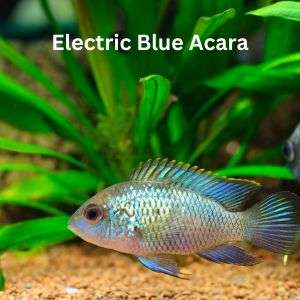
Electric Blue Acaras are native to South America, where they can be found in slow-moving rivers, streams, and lakes. They are particularly common in the Amazon River basin, where they live in areas with dense vegetation and sandy or muddy substrates.
The appearance of Electric Blue Acaras
As their name suggests, Electric Blue Acaras are known for their vibrant blue coloration, which is caused by iridophores in their skin. However, their color can vary depending on their mood and environment, and they may also display black or yellow markings on their fins and body.
Electric Blue Acaras have a compact, oval-shaped body and can grow up to six inches in length. They have a large head and mouth, with sharp teeth that are used to crush and eat their food. Their fins are long and flowing, with a distinctive spiny dorsal fin.
Tank Setup for Electric Blue Acara
Creating the perfect environment for your Electric Blue Acara is crucial for their wellbeing. To ensure they thrive in your aquarium, it’s essential to consider the ideal tank size, water parameters, filtration, and decorations that replicate their natural habitat.
Tank Size
Electric Blue Acaras require a spacious tank to accommodate their active nature. A minimum tank size of 30 gallons is recommended for a pair of Electric Blue Acaras. However, if you plan to keep a small community, a larger tank of 40-50 gallons is more suitable.
Water Parameters
“Maintaining optimal water conditions is vital for the health of your Electric Blue Acara.”
The ideal water temperature for Electric Blue Acaras ranges from 76°F to 82°F (24°C to 28°C). Aim for a pH level between 6.5 and 7.5, with slightly acidic to neutral water. It’s crucial to maintain water quality by regularly testing and performing water changes.
Filtration
“Providing efficient filtration is essential for the overall health and well-being of your Electric Blue Acara.”
Choose a filter that suits the size of your tank and provides effective mechanical, chemical, and biological filtration. This will help remove waste, maintain water clarity, and establish a healthy ecosystem for your fish.
Decorations
When setting up the tank, consider adding driftwood, rocks, and plants to create natural hiding spots and territories for your Electric Blue Acaras. Provide a sandy substrate as they enjoy digging and sifting through the substrate.
| Aspect | Ideal Range |
|---|---|
| Temperature | 76°F – 82°F (24°C – 28°C) |
| pH Level | 6.5 – 7.5 |
| Tank Size | 30 gallons (for a pair), 40-50 gallons (for small community) |
By carefully considering the tank size, water parameters, filtration, and decorations, you can create a thriving and comfortable environment for your Electric Blue Acara.
Water Parameters for Electric Blue Acara
Maintaining proper water quality is vital for ensuring the overall health and well-being of your Electric Blue Acara. To create an environment that supports their thriving aquarium life, it is crucial to understand and maintain the ideal water parameters. Here are the key factors to consider:
Water Temperature
Electric Blue Acaras thrive in tropical freshwater environments. The recommended temperature range for these cichlids is between 75°F and 82°F (24°C and 28°C). It is important to provide a stable and consistent temperature to prevent stress and promote their overall health.
pH Level
The pH level of the water directly affects the well-being of Electric Blue Acara. Ideally, the pH should be maintained between 6.5 and 7.5, which is slightly acidic to neutral. Monitoring the pH and ensuring it remains within the appropriate range will help create a suitable habitat for your fish.
Water Hardness
Electric Blue Acaras prefer moderate water hardness. The ideal range for their environment is between 4 and 8 dKH (degrees of carbonate hardness). Maintaining the right water hardness level contributes to their overall health, well-being, and proper functioning of their biological systems.
Expert Tip: Regularly test the water parameters using reliable test kits to ensure they remain within the recommended range. This will help you identify any fluctuations or deviations and take appropriate measures to maintain a stable and healthy environment for your Electric Blue Acara.
By closely monitoring and maintaining the water temperature, pH level, and water hardness within the recommended range, you can create an optimal environment that supports the health, longevity, and vibrant colors of your Electric Blue Acara.
| Water Parameter | Ideal Range |
|---|---|
| Water Temperature | 75°F – 82°F (24°C – 28°C) |
| pH Level | 6.5 – 7.5 |
| Water Hardness (dKH) | 4 – 8 |
Feeding Your Electric Blue Acara
A balanced diet is essential to keep your Electric Blue Acara healthy and vibrant. Feeding them the right food and following proper techniques will ensure their optimal growth and well-being. Let’s explore the feeding habits and requirements of these stunning cichlids, taking into account their size and nutritional needs.
The Optimal Diet for Electric Blue Acara
Electric Blue Acaras are omnivorous by nature, meaning they require a combination of both plant-based and protein-rich foods. A varied diet consisting of high-quality pellets, flakes, frozen or live foods, and fresh vegetables is recommended to meet their nutritional requirements. Including a mix of these food sources will provide essential vitamins, minerals, and proteins necessary for their overall health and vibrant coloration.
Feeding Techniques for Electric Blue Acara
It is important to establish a feeding routine and monitor the amount of food given to your Electric Blue Acara. Overfeeding can lead to health problems and poor water quality. Feed your fish small amounts multiple times a day, rather than a large meal at once.
Pro Tip: Electric Blue Acaras are opportunistic feeders and tend to consume food from various levels of the aquarium. Offer a mix of sinking pellets for the bottom dwellers and floating flakes for the mid to upper-water column feeders.
Recommended Food Options Based on Size
The size of your Electric Blue Acara will determine the appropriate food options for them. Here are the recommended food choices for different stages of their growth:
| Electric Blue Acara Size | Recommended Food Options |
|---|---|
| Juveniles (less than 2 inches) | High-quality micro pellets, baby brine shrimp, crushed flakes |
| Subadults (2-3 inches) | Small pellets, bloodworms, daphnia, vegetable matter |
| Adults (3 inches or more) | Medium-sized pellets, krill, earthworms, spirulina-based foods |
Observe your Electric Blue Acara’s feeding behavior to ensure they are consuming their food adequately. Adjust the portion sizes and types of food based on their individual needs and growth rate.
By providing a well-balanced and varied diet tailored to their size, you can ensure the optimal health and stunning appearance of your Electric Blue Acara.
Behavior and Temperament of Electric Blue Acaras
Electric Blue Acaras are generally peaceful and make great community fish, but they can become territorial during breeding or if they feel threatened. It’s important to provide plenty of hiding spots and caves in the tank to allow them to establish their own territory.
These fish are also known for their curious and active behavior, and will often explore their environment and interact with other fish. They may also display some digging behavior, which is a natural instinct to create a nest for breeding.
Breeding Electric Blue Acara
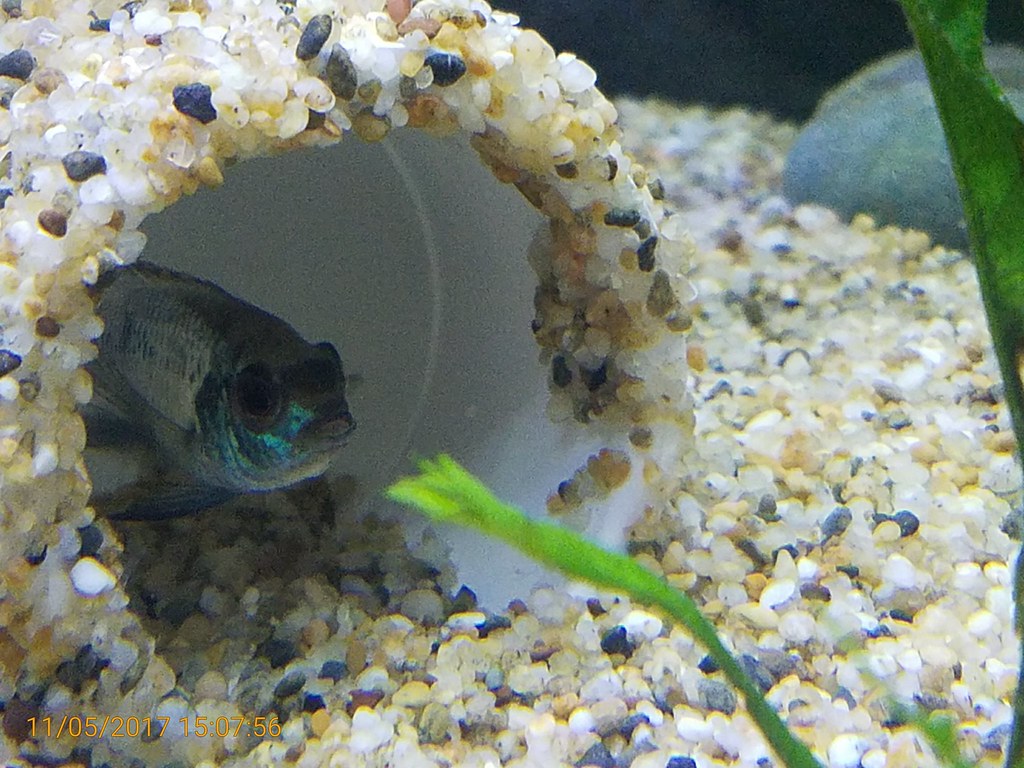
Breeding Electric Blue Acara can be a truly fulfilling and rewarding experience for aquarium enthusiasts. These beautiful freshwater cichlids exhibit fascinating breeding behaviors and produce a considerable number of eggs in each spawning event. Understanding their breeding requirements and providing the right conditions is key to successful breeding.
When it comes to breeding Electric Blue Acara, creating an environment that mimics their natural habitat is crucial. They prefer soft and slightly acidic water with a pH ranging from 6.5 to 7. They thrive in temperatures between 78-82°F (25-28°C). Maintaining stable water parameters is essential to ensure their comfort and stimulate breeding behavior.
During the breeding process, a pair of Electric Blue Acara will establish a territory and engage in courtship rituals. The male will display vibrant colors and exhibit various courtship behaviors to attract the female. Once the pair has formed a strong bond, they will choose a suitable site to lay their eggs.
H3: Breeding Behavior of Electric Blue Acara
The male Electric Blue Acara is responsible for cleaning and preparing the chosen spawning site. He will typically clean surfaces such as rocks, logs, or even broad-leaved plants using his mouth to create a clean and inviting spot for the female to lay her eggs. Once the preparations are complete, the female will carefully lay her eggs on the cleaned surface, while the male follows closely to fertilize them. After laying a batch of eggs, the female will guard them while the male continues to defend the territory.
Electric Blue Acara parents exhibit exceptional care for their eggs and fry. Both the male and female take turns guarding the nest and ensuring the eggs receive ample oxygen and protection. They will fan the eggs with their fins to maintain water circulation and remove any debris that might settle on them.
After about 3-4 days, the eggs will hatch into small fry. At this stage, the fry rely on their yolk sac for nourishment. As they grow, they will eventually consume external food. It is crucial to provide them with highly nutritious and finely crushed foods such as baby brine shrimp or specialized fry food to support their development and growth.
H3: Number of Eggs Laid by Electric Blue Acara
Electric Blue Acara are known to lay a relatively large number of eggs per spawning event. On average, a pair of Electric Blue Acara can lay anywhere between 150-200 eggs, although there have been cases where they have laid as many as 500 eggs. The number of eggs produced can vary depending on the age, health, and breeding history of the pair.
| Breeding Behavior | Ideal Conditions |
|---|---|
| Courtship rituals | Stable water parameters with temperatures between 78-82°F (25-28°C), pH ranging from 6.5 to 7 |
| Egg-laying | Male prepares clean spawning site, female carefully lays eggs |
| Egg care | Both parents guard the eggs, fan them for circulation, and remove debris |
| Fry care | Fry rely on yolk sac initially, then provide crushed baby brine shrimp or fry food |
| Number of eggs laid | Average of 150-200 eggs per spawning event, variations can occur |
Common Health Problems of Electric Blue Acaras
Electric Blue Acaras are generally hardy fish, but they can be prone to some common health issues like bacterial infections, parasitic infestations, and fungal infections. It’s important to regularly observe your fish for any signs of illness, such as lethargy, loss of appetite, or abnormal behavior.
To prevent illness, it’s important to maintain a clean and healthy environment in the tank, with proper filtration and water quality. Quarantining new fish before introducing them to the tank can
also help prevent the spread of disease. If you suspect your Electric Blue Acara is sick, it’s best to consult with a veterinarian or experienced fish hobbyist for proper diagnosis and treatment.
Electric Blue Acara Tank Mates
Choosing the right tank mates for your Electric Blue Acara is essential to ensure a peaceful and harmonious community tank. Here are some compatible fish species that can coexist with this stunning cichlid without any conflicts:
- Angelfish: These graceful freshwater fish can peacefully cohabitate with Electric Blue Acaras, as long as they have enough space in the tank.
- Bristlenose Pleco: Known for their algae-eating abilities, Bristlenose Plecos are a great addition to the tank, helping to keep it clean.
- German Blue Ram: Both the Electric Blue Acara and the German Blue Ram prefer similar water conditions, making them compatible tank mates.
- Neon Tetra: These small, colorful fish can add a vibrant touch to your tank and get along well with Electric Blue Acaras.
- Bolivian Ram: With their peaceful nature, Bolivian Rams are an excellent choice as tank mates for Electric Blue Acaras.
- Otocinclus Catfish: These small catfish are known for their algae-eating habits and can peacefully coexist with Electric Blue Acaras.
Remember, when selecting tank mates for your Electric Blue Acara, it’s important to consider factors such as tank size, temperament, and water parameters to ensure a harmonious and thriving community tank.
Electric Blue Acara Behavior and Personality
Understanding the behavior and personality traits of Electric Blue Acaras is crucial for providing them with an optimal environment in your aquarium. These beautiful cichlids have distinct characteristics that make them a fascinating addition to any freshwater tank.
Temperament
The Electric Blue Acara is generally known to be a peaceful fish, making it suitable for community tanks. However, their temperament can vary depending on factors such as tank size, compatibility with tank mates, and individual personality differences. Some Electric Blue Acaras may display territorial behavior, especially during breeding or when establishing their space within the aquarium.
Tip: To minimize potential aggression, provide ample hiding places and territories within the tank to allow each fish to establish its own space.
Digging Habits
Blue Acaras, including Electric Blue Acaras, are known for their natural digging instinct. They may rearrange substrates, move decorations, or create small pits in the aquarium. This behavior is part of their natural foraging instincts and territorial behavior, which can be observed both during the breeding process and as a general exploration and expression of their innate nature.
Overall Demeanor
The Electric Blue Acara is an active and curious fish that enjoys exploring its surroundings. They are known to be intelligent and quick to adapt to their environment. While they may not be as interactive as some other fish species, they can still recognize their owners and show a mild level of curiosity towards them, especially during feeding time.
Their vibrant colors and graceful swimming movements make them a mesmerizing addition to any aquarium, providing a captivating display of beauty and elegance.
Electric Blue Acara Personality Traits
| Trait | Description |
|---|---|
| Temperament | Generally peaceful, but territorial behavior may occur |
| Digging Habits | Natural foraging and territorial behavior |
| Curiosity | Quick to adapt to their environment and show mild curiosity |
Understanding the behavior and personality of your Electric Blue Acaras will help you create a harmonious and stimulating environment for them. By providing spaces for territorial establishment and ensuring a proper substrate for digging, you can enhance their overall well-being and enjoy the captivating beauty they bring to your aquarium.
Lifespan and Size of Electric Blue Acara
When considering adding Electric Blue Acaras to your aquarium, it’s important to understand their expected lifespan and how their size evolves over time. These factors play a significant role in providing optimal care for these beautiful cichlids.
The lifespan of a Blue Acara can range from 8 to 12 years when provided with proper care and a suitable environment. However, it’s crucial to note that individual lifespan can vary depending on factors such as water quality, diet, and overall health.
As for their size, Electric Blue Acaras start off small but grow relatively large compared to other freshwater fish species. On average, they reach a size of 6 to 8 inches (15 to 20 cm) in captivity. However, there have been instances where well-cared-for Blue Acaras have grown even larger, reaching lengths of up to 10 inches (25 cm)!
It’s important to consider the potential size of Electric Blue Acaras when planning their tank setup. Providing them with enough space to swim and grow comfortably is essential for their overall well-being.
| Electric Blue Acara Lifespan | Electric Blue Acara Size |
|---|---|
| 8 to 12 years | 6 to 8 inches (15 to 20 cm) |
Keeping Electric Blue Acara in a Community Tank
Electric Blue Acaras can thrive in a community tank under certain conditions. However, it’s essential to choose tank mates that are compatible with their temperament and requirements. Let’s explore some common questions regarding the feasibility of keeping Electric Blue Acara in a community tank.
Availability and Cost of Electric Blue Acaras
Electric Blue Acaras are readily available in most pet stores and online fish stores. The cost of these fish can vary depending on their size and location, but they are generally affordable for most hobbyists.
Conclusion
In conclusion, Electric Blue Acaras are a beautiful and interesting species of fish that make great additions to a community aquarium. They are relatively easy to care for and can provide a rewarding breeding experience for experienced hobbyists. With proper tank setup, water conditions, and a balanced diet, these fish can thrive in a home aquarium.
FAQ
Can Electric Blue Acaras be kept with other fish?
Yes, Electric Blue Acaras can be kept with other community fish that are of similar size and temperament.
What size tank do Electric Blue Acaras need?
Electric Blue Acaras require a minimum of 30 gallons of water per fish.
What do Electric Blue Acaras eat?
Electric Blue Acaras are omnivores and require a balanced diet that includes both plant and animal matter.
How do you breed Electric Blue Acaras?
To breed Electric Blue Acaras, it’s important to provide a suitable breeding environment with plenty of hiding spots and caves. Once a pair has formed, the male will prepare a nest for the female to lay her eggs.
How much do Electric Blue Acaras cost?
The cost of Electric Blue Acaras can vary depending on their size and location, but they are generally affordable for most hobbyists.
Can Electric Blue Acaras be kept in a planted tank?
Yes, Electric Blue Acaras can be kept in a planted tank. However, they may uproot plants or disturb the substrate while establishing their territory, so it’s important to choose hardy plants and provide a stable substrate.
What is the ideal water temperature for Electric Blue Acaras?
Electric Blue Acaras prefer a water temperature between 75-82°F (24-28°C).
How long do Electric Blue Acaras live?
With proper care, Electric Blue Acaras can live up to 5-7 years in captivity.
Can Electric Blue Acaras be kept with other cichlids?
While Electric Blue Acaras can be kept with other cichlids, it’s important to choose compatible species and provide plenty of hiding spots and territory to avoid aggression.
What are some common health issues that Electric Blue Acaras may experience?
Some common health issues that Electric Blue Acaras may experience include bacterial infections, parasitic infections, and swim bladder issues. It’s important to monitor their behavior and health regularly and provide appropriate care if needed.
In summary, Electric Blue Acaras are a beautiful and interesting species of fish that can make a great addition to a community aquarium. With proper care and attention, they can thrive in a home aquarium and provide a rewarding breeding experience for experienced hobbyists. As with any pet, it’s important to provide a suitable environment, balanced diet, and appropriate care to ensure their health and well-being.
Are Electric Blue Acaras aggressive?
Electric Blue Acaras can become territorial during breeding or if they feel threatened, but they are generally peaceful and can be kept with other community fish of similar size and temperament.
How often should you feed Electric Blue Acaras?
Electric Blue Acaras should be fed 1-2 times per day with a balanced diet that includes both plant and animal matter.
What size do Electric Blue Acaras grow to?
Electric Blue Acaras can grow up to 6 inches (15 cm) in length.
What is the ideal pH level for Electric Blue Acaras?
Electric Blue Acaras prefer a pH level between 7.0-8.0.
Can Electric Blue Acaras live in brackish water?
No, Electric Blue Acaras are freshwater fish and cannot tolerate brackish water.
What is the ideal lighting for Electric Blue Acaras?
Electric Blue Acaras prefer moderate to low lighting in their tank.
How often should you change the water in an Electric Blue Acara tank?
It’s recommended to change 10-20% of the water in an Electric Blue Acara tank every 1-2 weeks.
Can Electric Blue Acaras jump out of their tank?
Yes, Electric Blue Acaras are known to jump out of their tank, so it’s important to provide a secure lid.
How long does it take for Electric Blue Acaras to reach sexual maturity?
Electric Blue Acaras typically reach sexual maturity around 9-12 months of age.
Can Electric Blue Acaras be kept in a community tank with shrimp or snails?
While Electric Blue Acaras are generally peaceful, they may view shrimp and snails as prey and try to eat them, so it’s important to choose compatible tank mates.
What is the growth rate of Electric Blue Acaras?
The growth rate of Electric Blue Acaras can vary depending on various factors such as water quality, temperature, diet, and tank size. On average, Electric Blue Acaras can grow up to an inch (2.5 cm) in length every few months, but it can take up to a year for them to reach their full adult size of around 6 inches (15 cm). Providing a balanced diet and appropriate environment can help promote healthy growth.
What are some suitable tank mates for Electric Blue Acaras?
Electric Blue Acaras can be kept with other peaceful community fish of similar size and temperament such as tetras, rasboras, gouramis, and angelfish. However, it’s important to avoid keeping them with aggressive or fin-nipping fish as they can become stressed and territorial. It’s also recommended to avoid keeping them with small fish or invertebrates as they may view them as prey.
How many Electric Blue Acaras can be kept in a 55-gallon tank?
A 55-gallon tank is suitable for a small group of 2-4 Electric Blue Acaras. It’s important to provide adequate swimming space and hiding places for each fish to prevent territorial aggression. Overcrowding can also lead to poor water quality and stress, which can negatively affect the health of the fish.
How many Electric Blue Acaras can be kept in a 75-gallon tank?
A 75-gallon tank can accommodate a small group of 4-6 Electric Blue Acaras. It’s important to provide adequate swimming space and hiding places for each fish to prevent territorial aggression. Overcrowding can also lead to poor water quality and stress, which can negatively affect the health of the fish.
How can you distinguish a female Electric Blue Acara from a male?
It can be challenging to distinguish between male and female Electric Blue Acaras, as they exhibit similar physical characteristics. However, females tend to have a rounder and wider body shape compared to males. Additionally, during breeding, females may have a more noticeable “belly” as they carry and protect their eggs.
What is the difference between Blue Acaras and Electric Blue Acaras?
Blue Acaras (Aequidens pulcher) and Electric Blue Acaras (Andinoacara pulcher) are two closely related species of cichlids. The main difference between them is their coloration. Blue Acaras have a more subdued blue-gray body with darker vertical stripes, while Electric Blue Acaras have a brighter, more vibrant blue body with iridescent scales. Additionally, Electric Blue Acaras tend to be slightly smaller than Blue Acaras and have a more rounded head shape. In terms of care, their requirements are similar, and they can be kept together in a suitable environment.
What are the differences between male and female Electric Blue Acaras?
Male and female Electric Blue Acaras are difficult to distinguish based on physical characteristics alone, as they are similar in appearance. However, during breeding, males may develop more pointed dorsal and anal fins, and may exhibit more intense coloration than females. Females may have a more rounded and wider body shape, especially when carrying and protecting their eggs.
What is the typical price of an Electric Blue Acara?
The price of an Electric Blue Acara can vary depending on a variety of factors such as size, age, and location. On average, a juvenile Electric Blue Acara can cost between $10 to $20 USD, while an adult specimen can cost upwards of $30 to $50 USD. Additionally, prices may vary between different aquarium stores and online retailers. It’s important to purchase fish from reputable sources to ensure their health and well-being.
What is the breeding behavior of Electric Blue Acaras?
Electric Blue Acaras are known to be excellent parents and can breed in home aquariums under the right conditions. During breeding, the male will display bright colors and court the female by digging pits in the substrate and performing various displays. Once the female lays eggs, the male will fertilize them and guard the nest. The eggs will hatch in about three to four days, and the fry will be cared for by both parents. It’s important to provide a suitable breeding environment and a nutritious diet for both the breeding pair and the fry to ensure their health and survival.
What size tank is suitable for Electric Blue Acaras?
Electric Blue Acaras require a minimum tank size of 30 gallons to thrive, but a larger tank is recommended to provide ample swimming space and to accommodate their territorial behavior. A 55-gallon or larger tank is ideal for a pair or small group of Electric Blue Acaras, and it’s important to provide plenty of hiding places and territories to reduce aggression and promote natural behaviors. It’s also important to maintain proper water parameters and provide a suitable diet to ensure their health and well-being in the aquarium.
Can Blue Acara Live with Mollies?
Electric Blue Acaras can generally live with mollies, as long as the water conditions and tank size are appropriate. Both mollies and Electric Blue Acaras prefer similar water parameters, making them compatible tank mates.
Can Firemouth Live with Blue Acara?
Combining Firemouth cichlids with Electric Blue Acaras can be challenging as both species are territorial. While tank size and proper acclimation can help reduce conflicts, closely monitoring their interactions is essential to prevent aggressive behavior.
Will Electric Blue Acara Eat Fish?
While Electric Blue Acaras are generally peaceful and non-aggressive, their behavior can vary from individual to individual. In a community tank setting, they may coexist peacefully with most fish species. However, it is essential to understand that each fish has its own unique personality and may exhibit predatory tendencies towards smaller tank mates. Therefore, it is advisable to avoid pairing them with extremely tiny or delicate fish.
Will Electric Blue Acara Eat Cardinal Tetras?
Cardinal Tetras are small, vibrant fish that can be a visually appealing addition to any aquarium. Electric Blue Acaras are usually compatible with Cardinal Tetras, as long as the tetras are not significantly smaller in size. Nonetheless, it is crucial to monitor their interactions closely, especially during the initial introduction to ensure peaceful cohabitation.
Will Electric Blue Acara Eat My Plants?
Electric Blue Acaras are generally not known to be heavy plant eaters. However, they may uproot or nibble on plants that are not securely rooted in the substrate. To prevent this, it is recommended to use heavy root feeders or anchor the plants using rocks or other decorations. Additionally, providing sufficient hiding spots and visual barriers with floating plants can help to minimize any potential disturbances.
Will Electric Blue Acara Eat Pest Snails?
Electric Blue Acaras may consume small invertebrates and pest snails if they encounter them in the aquarium. While some aquarists consider them beneficial in controlling snail populations, it is important to note that they may not eliminate an infestation entirely. Therefore, if you have a significant snail problem, it is advisable to explore other methods of population control or seek assistance from a local fish store.
Is My Blue Acara Male or Female?
Determining the gender of Electric Blue Acaras can be challenging, especially when they are young. As they mature, males may develop more elongated dorsal and anal fins, while females tend to have shorter and rounder fins. Additionally, males often exhibit brighter colors and may display more aggressive behavior during breeding. However, the most accurate method to determine their gender is by examining their vent region, where males develop a more pointed genital papilla compared to the rounder one in females.
Is the Electric Blue Acara aggressive?
While the Electric Blue Acara can exhibit territorial behavior, they are generally peaceful compared to other cichlid species. However, it’s important to provide them with enough space and suitable tank mates to prevent aggression.
How big do Electric Blue Acara cichlids get?
Electric Blue Acaras can reach a size of around 6 inches (15 cm) when fully grown. It’s important to provide them with an adequately sized tank to accommodate their growth.
Do Electric Blue Acaras lay eggs?
Yes, Electric Blue Acaras are egg-laying fish that engage in parental care. They will lay their eggs on carefully chosen substrates or flat surfaces and guard them until they hatch.
How many eggs do Electric Blue Acaras lay?
Electric Blue Acaras can lay anywhere from 100 to 500 eggs per spawn, depending on various factors such as the age and size of the female.
What is the least aggressive cichlid?
The Keyhole Cichlid (Cleithracara maronii) is widely regarded as one of the least aggressive cichlid species. They are peaceful, social, and can be a good choice for community tanks.
What is the easiest cichlid for a beginner?
The Firemouth Cichlid (Thorichthys meeki) is considered one of the easiest cichlids for beginners. They have relatively peaceful behavior, are hardy, and adapt well to different water conditions.
What is the most aggressive cichlid breed?
The Red Devil Cichlid (Amphilophus labiatus) is known for its aggressive behavior and territorial nature, making it one of the most aggressive cichlid breeds. They are generally not recommended for community tanks.
What is the scientific name of a Blue Acara fish?
The scientific name of the Blue Acara fish is Andinoacara pulcher.
Is there more than one type of Blue Acara?
The Blue Acara is the most common species in its group, but there are other related species in the Andinoacara genus. Each one has its own scientific name.
References
| Organization | Website |
| American Cichlid Association | https://cichlid.org/ |
| Aquatic Community | https://www.aquaticcommunity.com/ |
You may also be interested in other fishkeeping-related articles please check out
Rummy Nose Tetra Fish: A Comprehensive Guide to its Care, Breeding and More
How to Care for Cherry Shrimp in Your Aquarium | Tips and Tricks
Everything You Need to Know About Caring for Blue Zebra Cichlids in Your Aquarium
Everything You Need to Know About Torch Coral: A Stunning Addition to Your Marine Aquarium
The Fascinating Penguin Tetra: Thayeria boehlkei (2023-24)
The Ultimate Guide to Scarlet Badis Care and Breeding
The Ultimate Bamboo Shrimp | Flower Shrimp Guide Which You Dont Want to Miss Out 2023
The Vibrant and Captivating Strawberry Peacock Cichlid: A Guide to Care and Maintenance
Electric Blue Acara: The Ultimate Guide To Care And Keeping
Best Fish for a 40 Gallon Tank: Top Choices for a Thriving Aquarium
Simple Guide to Easy-to-Care-for Aquarium Plants
Discover the Diverse Corydoras Catfish Varieties- A Guide
Get to Know Various Types of Algae Eaters
Master Guide: Best Water Parameters for Goldfish Care 2023-24
Mastering Black Ghost Knife Fish Care: A Comprehensive Guide
Optimal pH Levels for Tropical Fish: Essential Aquarium Guide
Discovering Freshwater Snail Species: An In-depth Guide
Expert Tips for Breeding Guppies: Keys to Successful Fishkeeping
Discover Peaceful Community Fish: Your Guide to Calm Aquatics
Ultimate Guide to Live Food for Betta Fish — Healthy Choices
Complete Guide to Your Perfect Cichlid Tank Setup
Your Guide to the Best Substrate for Planted Aquariums
Essential Guide to Discus Fish Care: Help Your Pets Thrive!
Grow Your Own Eden: Beginner-Friendly Aquascaping Plants Guide
Perfect Neon Tetra Tank Mates: Guide to Aquarium Harmony
Product Review of Eheim Classic vs Professional
The Ultimate Guide to Discus Fish Care
What Fish Can Live With Discus?
Ideal pH for Discus Fish | Aquarium Water Guide
How to Sex Discus Fish?: A Simple Guide for Hobbyists
Complete Discus Fish Tank Setup Guide
Can Discus Fish Live With Angelfish? The Complete Guide
Discus Diet Guide: What Do Discus Fish Eat?
Are Discus Fish Hard to Keep? Insights & Tips.
Optimal Discus Fish Water Parameters Guide
Discus Fish Size Guide 2024: How Big Do Discus Fish Get?
Ultimate Million Fish Guppy Care Guide 2024
Simple Guide to Easy-to-Care-for Aquarium Plants
Grow Your Own Eden: Beginner-Friendly Aquascaping Plants Guide
Hornwort Aquarium Plants: The Ultimate Guide to Care and Maintenance
Aquarium Equipment for Beginners: The Complete Checklist
Feeding Your Aquarium Fish: The Complete Guide
Common Beginner Fishkeeping Mistakes and How to Avoid Them!
Aquarium Plants for Beginners: Easy Care and Beautiful Options
Keeping Your Aquarium Water Clean and Healthy: The Complete Guide
Breeding Aquarium Fish: A Comprehensive Guide
All You Need to Know About Keeping Angel Fish in Your Aquarium
Marine Aquariums: The Ultimate Challenge for Experienced Hobbyists
Tech in the Tank: Must-Have Gadgets for Aquarium Automation
Dwarf Sucking Catfish : The Ultimate Guide to Keeping and Caring for Oto Catfish
The Science of Aquarium Water Chemistry: Understanding pH, KH, and GH
Veiltail Goldfish: The Exquisite Beauty of Flowing Fins
Perfect Neon Tetra Tank Mates: Guide to Aquarium Harmony
Goldfish Care: Beyond the Bowl – Everything You Need to Know
Master Red Tail Shark Care: Tips, Tank Mates & Surprising Traits!
Sheepshead Wrasse Facts & Habitat Guide
Unveiling the Unique Asian Sheepshead Wrasse: A Fascinating Reef Fish with Quirky Behavior
Peacock Wrasse: A Dazzling Addition to Your Aquarium
Vibrant Wrasse Fish: Care Guide & Species Info
Bluestreak Cleaner Wrasse – Vibrant Reef Ally
Coris Wrasse Care Guide for Saltwater Aquariums
Melanurus Wrasse Care Guide & Habitat Tips
The Ultimate Guide to Kuhli Loach
The Ultimate Guide to Popular Loach Species for Freshwater Tanks
Yoyo Loach: The Ultimate Guide to This Fun and Friendly Fish
How to Care for Clown Loaches: The Ultimate Guide for Aquarium Lovers
Optimal Times to Feed Tropical Fish Daily
How to Care for Dojo Loach, the Friendly and Playful Aquarium Fish
How to Care for Zebra Loach: The Ultimate Guide for Beginners
Fu Manchu Lionfish: The Most Beautiful and Mysterious Fish in the Ocean?
The Ultimate Guide to Lionfish Sting: Symptoms, Treatment, and Prevention
Caring for Dwarf Lionfish: Tips & Facts
Hillstream Loach: The Ultimate Guide to Keeping These Unique Fish
The Complete Guide to Platy Fish: Care, Varieties, and Breeding Tips
Endlers Livebearers Care & Breeding Tips
Livebearer Species: The Ultimate Guide
Livebearers vs. Egglayers: Understanding Fish Reproduction
Rosy Barb Care 101: Tank Mates, Size, Breeding, Diet & More
The Complete Oranda Goldfish Care Guide: From Tank Setup, Feeding to Breeding
What Do Koi Fish Eat? Optimal Diet Tips
Koi Fish Lifespan: Facts & Tips Unveiled
Koi Fish Prices: How Much Do Koi Fish Cost?
Unveiling Koi Fish Sizes: How Big Do Koi Fish Get?
Exploring Types of Koi Fish for Your Pond
Butterfly Koi Fish Care Tips and Habitat Guide
Can You Eat Koi Fish? Unveiling the Facts
Top 10 Fish for a Planted Aquarium, everything you need to know
Master Breeding Techniques for Angelfish – A Guide for Hobbyists
Do Angel Fish Need a Heater? Find Out Here!
A Comprehensive Guide to Different Types of Angelfish
All You Need to Know About Keeping Angel Fish in Your Aquarium
Thanks.
I am a passionate aquarist with over 30 years of hands-on experience in fishkeeping. My journey began at a young age, collecting fish from the wild and learning through experimentation. Specializing in tropical fish, I bring a deep understanding of the hobby to FishKeepingMadeSimple. The site provides honest, detailed reviews of essential products and accessories to help fellow enthusiasts create the best environments for their fish.




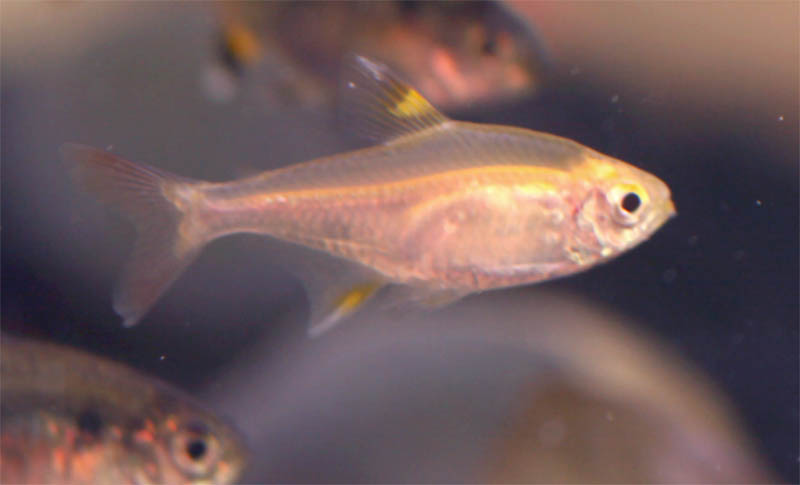
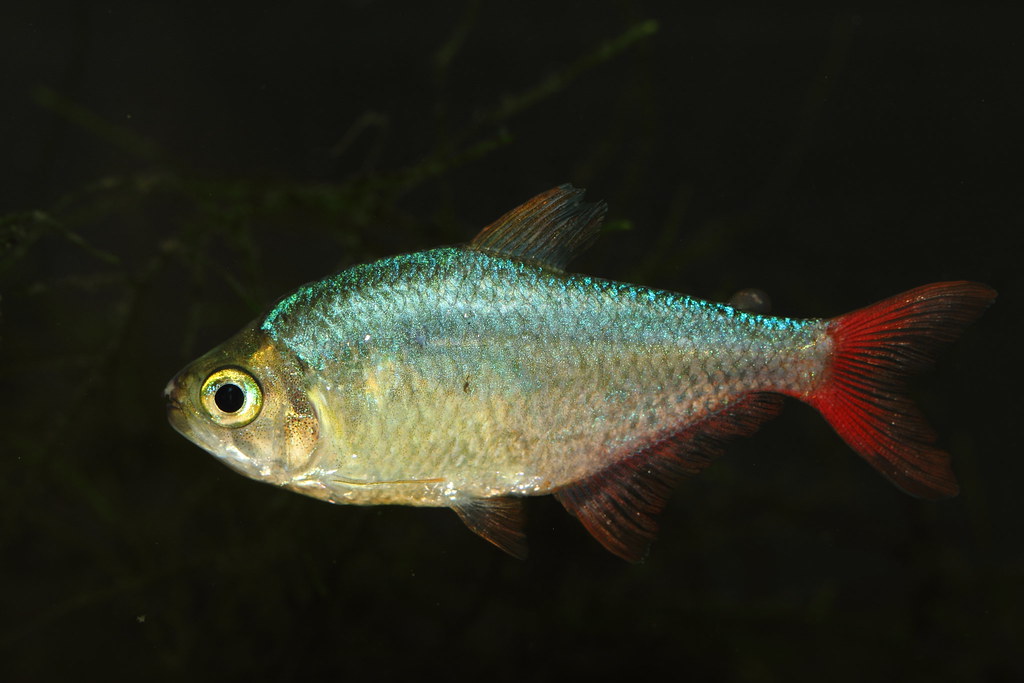
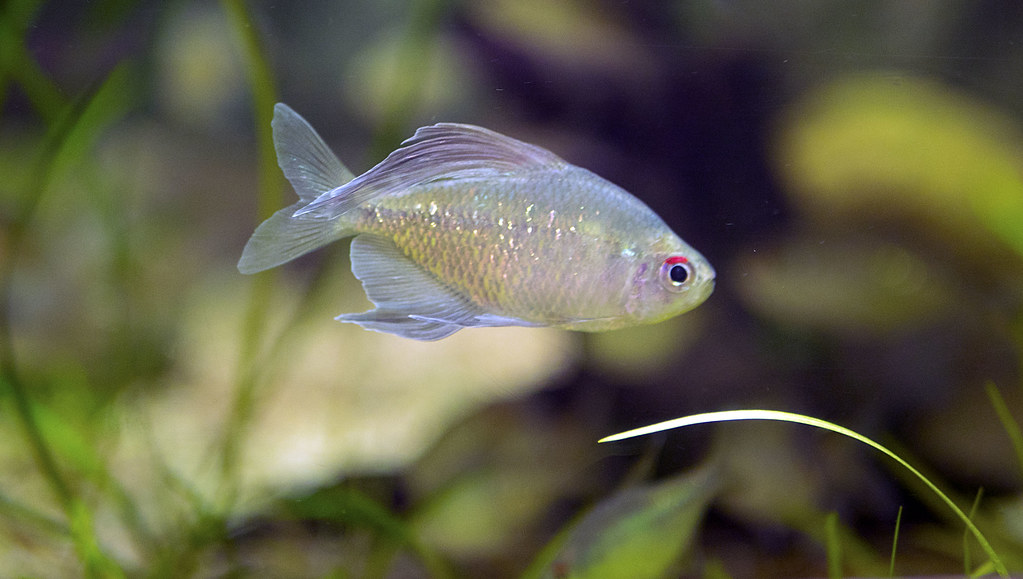
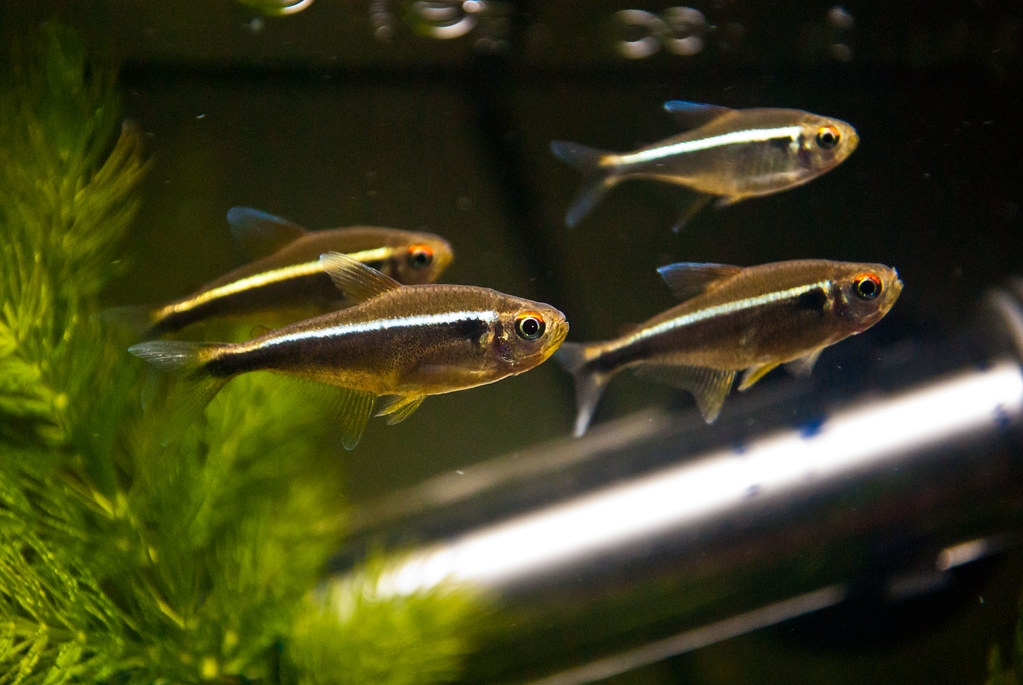
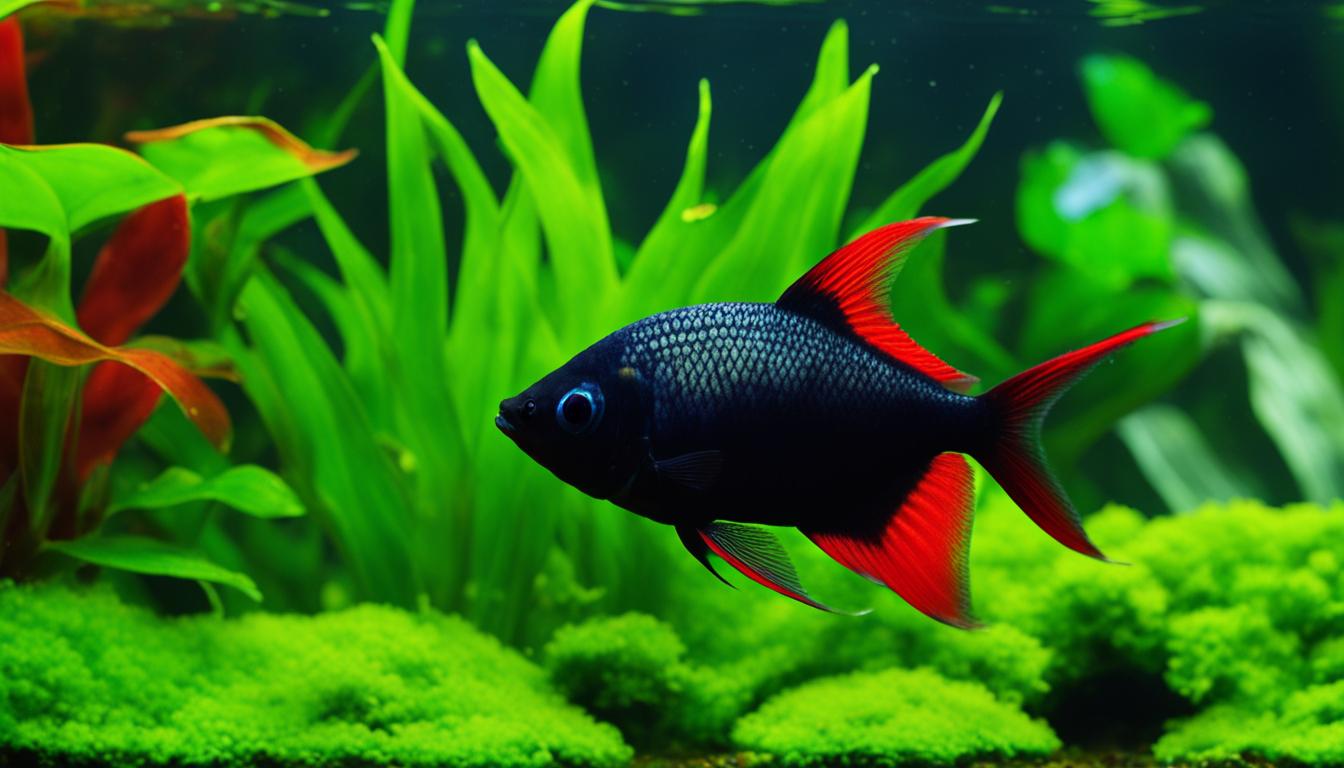

[…] this ultimate guide, I will take you on a journey through the various livebearer species, their care requirements, and […]
[…] various protein sources, maintaining a balanced intake that aligns with the heightened demand for Tropical Fish […]
[…] selection of the best fish for Arowana aquariums requires careful consideration. Understanding the compatibility of potential companions is crucial to ensuring a […]
quisquam molestiae similique distinctio et aut illo molestias illum iusto quo non dolorem omnis. aliquam blanditiis assumenda accusantium minima sit sed dolores laudantium. omnis aut quia sunt aut qui